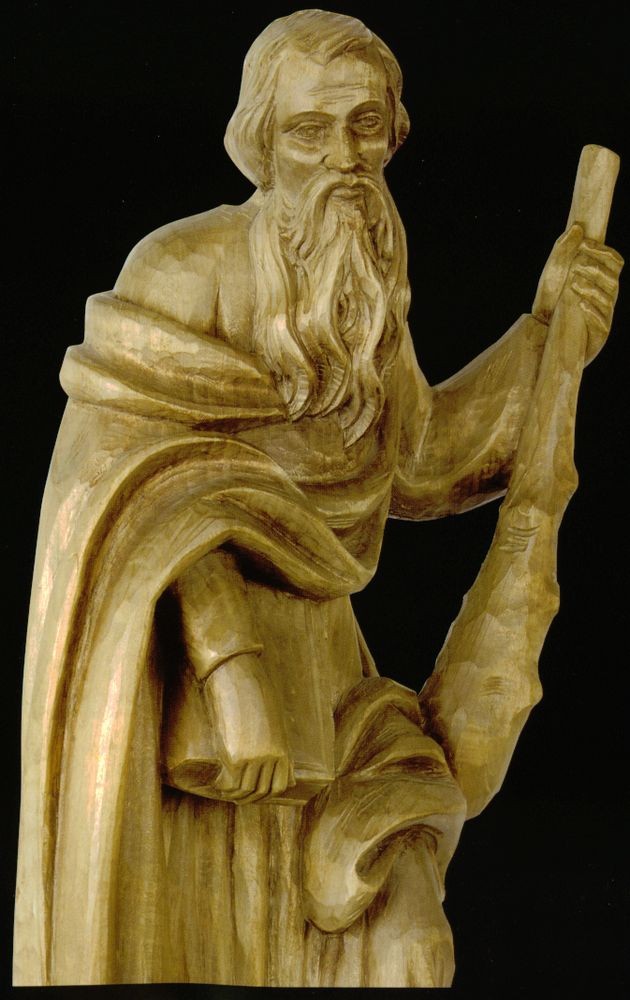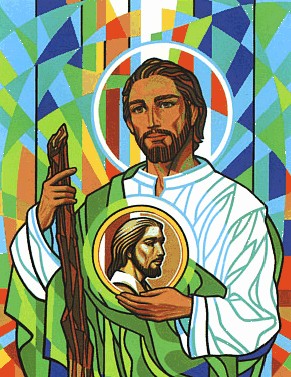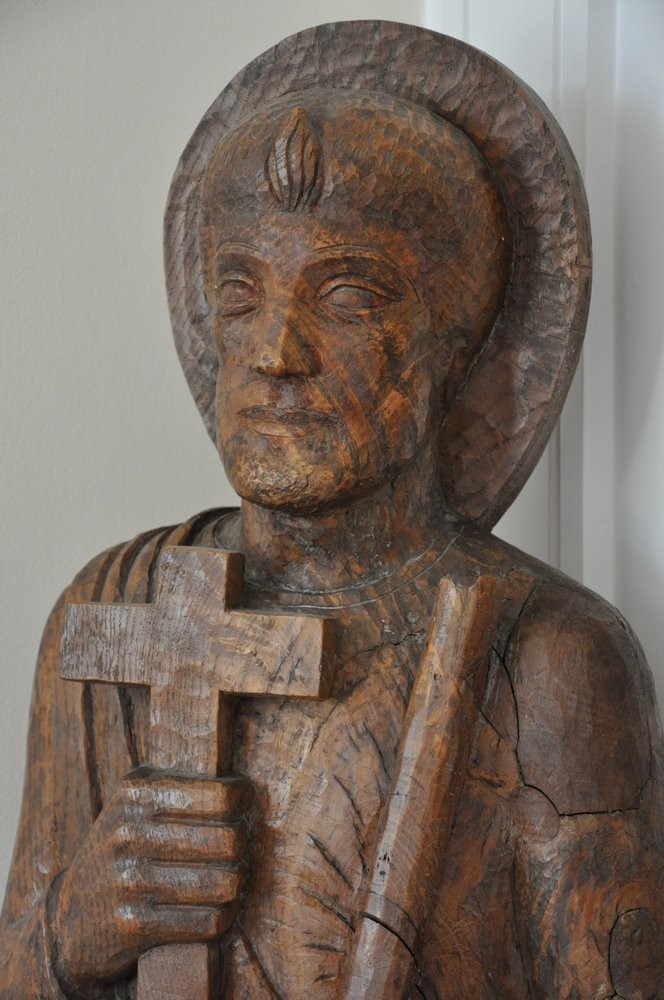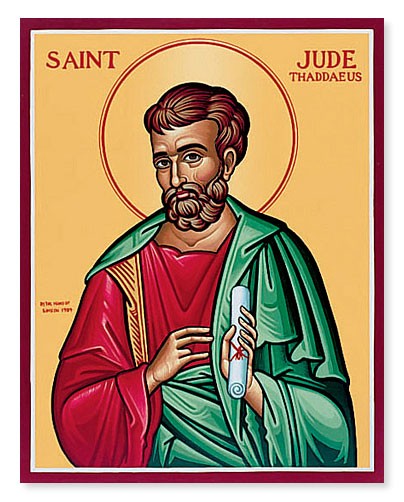Feast Day – 28 October
Saint Jude was one of the Twelve Apostles appointed by Jesus to lead his Church.
In the list of the Apostles given in the Gospel accounts he is generally identified with “Thaddeus”, and is variously known as Jude Thaddaeus, Judas Thaddaeus, Jude (brother or son) of James (Luke 6:16; Acts 1:13), or Lebbaeus. He is sometimes identified with Jude, referred to in the Bible as “brother” or “kinsman” of Jesus (Luke 6:16; Mark 6:3; Matthew 13:55-57). Some Latin manuscripts of Matthew 10:3 refer to him as Judas the Zealot.
For many centuries he was wrongly confused with Judas Iscariot, the disciple who betrayed Jesus. The Gospel of John refers to a disciple called “Judas not Iscariot” (John 14:22). He is also not to be confused with “Thaddeus of Edessa”, one of the seventy disciples sent out by Jesus to proclaim the Kingdom of God.
The Letter or Epistle of Saint Jude in the Bible is usually attributed to the Apostle Jude, and though a short text it is a beautiful piece of Holy Scripture (to read it click here).
Very little is known about Jude’s life after the death and resurrection of Jesus, but the ancient tradition of the Church is that he preached the Gospel in the Middle East, namely Judea, Samaria, Idumaea, Syria, Mesopotamia, Libya, Beirut and Edessa.

Little is known about Jude’s later life, but the ancient tradition of the Church is that after preaching about the Good News of God’s love for all Jude died as a martyr, giving his life in witness to Jesus Christ. According to the tradition of the Christians in Armenia, Jude was martyred about 65AD in the Lebanon town of Beirut, together with the apostle Simon the Zealot. The Roman Catholic Church recalls the memory of Saints Simon and Jude on 28th October, which is a busy time at the National Shrine of St. Jude at Faversham.
Saint Jude in religious art
 In religious art Saint Jude is normally shown holding a club, axe or palm branch, the symbols of his martyrdom, or a scroll or book containing his epistle. Another common attribute in depictions of Jude is to show him holding an image of Jesus, symbolising his relationship to Christ as a blood relative, or a carpenter’s rule, showing that he was a follower of Jesus, the carpenter of Nazareth. In icons Jude is often shown with a flame around his head, representing his receiving the gift of the Holy Spirit at Pentecost with the other apostles.
In religious art Saint Jude is normally shown holding a club, axe or palm branch, the symbols of his martyrdom, or a scroll or book containing his epistle. Another common attribute in depictions of Jude is to show him holding an image of Jesus, symbolising his relationship to Christ as a blood relative, or a carpenter’s rule, showing that he was a follower of Jesus, the carpenter of Nazareth. In icons Jude is often shown with a flame around his head, representing his receiving the gift of the Holy Spirit at Pentecost with the other apostles.
Devotion to Saint Jude today
Jude is today revered as a saint with widespread devotion among Christians of many denominations, especially Roman Catholics and Orthodox.
In the Catholic tradition of Christianity (and others), saints – God’s holy men and women both on earth and in heaven – are regarded as models of how to follow Jesus Christ, and as “intercessors”. Because the saints in heaven live fully in the presence of God, yet are still bound to those living on earth by bonds of love, they present our needs to God. The saints are not a substitute for developing a personal relationship with God, but they can be regarded as our friends, asking God for what we truly need, even if we do not know what that need may be ourselves.
Various places in the world claim to have some of the mortal remains of Saint Jude preserved as relics, including St. Peter’s Basilica in Rome, and monasteries in Armenia. A relic of Saint Jude is held in great reverence at Faversham, and used to bless oil which people use as part of their prayer in asking for God’s gift of healing.
Saint Jude is the patron saint of various groups and places, and is best known as the patron of “desperate” or “difficult” cases (a term used in preference to the older title of “hopeless” cases, since with God no situation is hopeless).
To encourage devotion to St. Jude, it is common to acknowledge in writing any favours received from God by the saint’s intercession. He is frequently thanked in the personals column of many daily newspapers, both secular and religious, usually anonymously, in a phrase such as “Thank you St. Jude for favours granted.” Many devotees write to the National Shrine of St. Jude at Faversham, testifying to the power of the Apostle in their lives.
Saint Jude and the Carmelite Family

The National Shrine of Saint Jude at Faversham was built in the 1950s. Carmelites try to nurture a close relationship with Christ and his family – especially Mary the Mother of God – and so perhaps it was natural that devotion to Jude, Apostle and Kinsman of Christ, should have become popular in Carmelite communities, not only in Faversham but around the world. Today there are various small shrines, altars and statues of Jude found across the Carmelite Family worldwide. Carmelite friars, sisters and laity around the world have experienced God’s blessing through the intercession of St. Jude, and through the generosity of his friends who support the work of the Carmelites by their prayers and donations.
Some of the pilgrims who come to Faversham in honour of St. Jude
Saint Jude is also revered as a holy man by various faiths other than Christianity. A number of Hindu pilgrims come to the Shrine of Saint Jude in order to give reverence to him. All people of good will are welcome.
